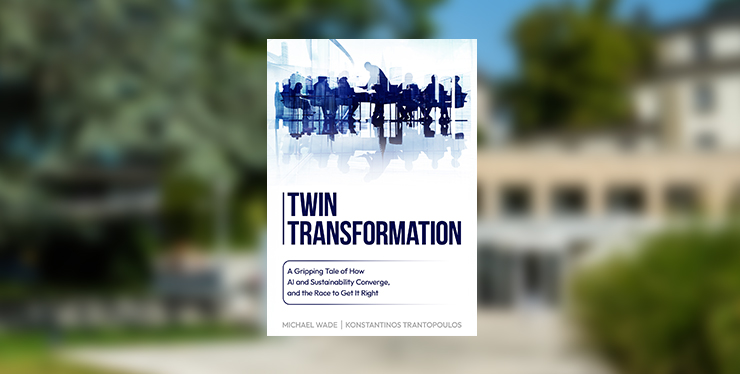About 140 participants gathered to learn about the impact that big data is having on real businesses from a variety of industries all over the world. They came away with tools to help them think about how they could use big data in their own companies and develop strategies to implement these new ideas.
Big data is a BIG deal for CEOs as it is having a huge impact on all types of companies – even those not using it themselves. In fact, it has reached a tipping point in almost every aspect of business.
It is no secret that companies like Amazon, Lego, Strava, Facebook and IBM are already leveraging the business benefits of big data. In 2012 a Hong Kong venture capital fund even appointed a computer program to its board. This incarnation of artificial intelligence, an algorithm called VITAL, will vote on investment decisions alongside its five human counterparts.
Meanwhile, new business models are emerging all the time. Speed of business used to be defined in months and days. Now it is counted in minutes and seconds.
Big data is omnipresent and part of everything we do. Are you prepared to lead your organization in this new era?
What is big data?
While there are many definitions of big data, IBM data scientists identified the four Vs of big data: Volume, Velocity, Variety and Veracity. Volume refers to the scale and size of data. For example, it is estimated that 2.5 quintillion bytes (2.3 trillion gigabytes) of information is generated each day. Velocity is about the speed at which streaming data is analyzed. Streaming data comes in many different forms, for example the New York Stock Exchange captures 1 trillion bytes of trade information during each trading session. Variety pertains to the different forms of data. Websites like Facebook generate 30 billion pieces of content each month, including tweets, videos, pictures and polls. Veracity refers to data uncertainty. Data is stored in different formats, some of which can quickly become obsolete. It is estimated that improper data formats cost the US economy US$3.1 trillion each year.
Your future depends on 7 seconds
In the last eight years, innovation has been characterized by two important phenomenon. The first is the move from useful to easy. In the earlier years of personal technology, software and hardware companies understood that customers had to learn how to use each new product, so most products came with extensive user manuals/instruction guides. This all changed in 2008 with the iPad, which came with just one document – the warranty. An instruction manual was unnecessary because users could find their way around it intuitively, prompting other software and technology companies to start thinking the Apple way and making their products user friendly and instinctive.
The second phenomenon is that people are increasingly using mobile devices. Three years ago 66% of people in India accessing the internet were doing so via mobile devices rather than with desktop computers. This trend is expected to spread and intensify. The question is, how are mobile device users different from desktop users? The answer is: 50 seconds.
Currently, it is standard industry knowledge, that desktop computer users decide within 57 seconds whether or not to continue shopping on a website. In that time they will make one of three important decisions: “I love it,” “I hate it,” or “I will come back later.”
For mobile devices users, that time frame is slashed to seven seconds. In a world dominated by mobile devices, companies have 50 seconds less to capture the attention of online customers. In those precious seven seconds, companies only have time to show one product. If they try to show more, they will fail because customers will feel that they have too much to choose from. So how do companies like Amazon, with over 10,000 products on offer, decide which product to show any particular user? They use big data to adapt their mobile device websites by processing the information at their disposal – such as geographical region, the type of device being used, and the user’s areas of interest (based on previous searches) – to better understand customers and predict what kind of product or service the customer will be most interested in. This is exactly what companies like Amazon and ebookers do: They analyze each user based on the internal and external big data at their disposal to decide which product to show in an effort to capture the interest of each individual customer.
By using big data, managers can move from ideas, code and data – the human aspect of website design – to machines learning, building and adapting by themselves. Creating machines that have the ability to learn and then develop prototypes also means empowering them to adapt websites to best serve individual customers. Thus, with big data, growth is no longer linear, it is exponential.
Big data best practices across industries: Patient 2.0
What sectors will be transformed by big data and digitalization? The truth is that all industries will be impacted. A survey indicated that CEOs in the pharmaceuticals industry believed that their industry would be least impacted by big data. Yet one pharmaceutical distributor, Mediq, based in the Netherlands, completely transformed its business model to one that depended entirely on the use of big data. Mediq used to simply distribute medicines and medical devices. Its revenues came chiefly from the fees it earned on the medicines it sold. But when the Dutch government changed the law whereby pharmacies in the Netherlands would be paid a “flat fee” for delivering drugs, the profits of the average pharmacy in the Netherlands dropped 90%, from €500,000 per year to just €50,000. Mediq’s directors were forced to take the company off the stock market and rethink its business model. This involved going back to the core purpose of the company and asking, “Why are we here?” The result was a complete change in focus, from “moving boxes” to “looking after patients.” In other words, Mediq became patient-centric and its goal was to become a trusted partner.
Using big data, Mediq discovered that 80% of the medicines it sold were for chronic conditions for which patients had repeat prescriptions. It also found that 99% of patients always collected their medicines from the same pharmacy. This allowed Mediq to forecast 80% of demand and thus drastically reduce warehouse stocks and costs. Meanwhile its pharmacists had more time to advise clients on how to take their medicines.
Another major benefit of using big data was a reduction in hospitalizations, 2.4% of which were due to incorrect use of medications, including taking too much, too little or the wrong medicine. This equated to 90,000 hospitalizations per year, which represented €85 million. Mediq used big data to check if patients were taking the appropriate drugs in the correct amounts and following up with patients when that was not the case. It also contracted a third party to calculate how much money insurance companies were saving as a result of Mediq’s services. It then used this information to negotiate with insurance companies, which agreed to pay half the amount saved each year to Mediq. This currently represents 50% of the company’s income.
Learning from big data in the sports industry
Sports professionals are using big data to improve the performance of individuals and teams, and many of the learnings from this industry could be applied to business.
First, the sports data business ecosystem is constantly evolving. Consumers benefit from this because the ecosystem’s role is to produce goods and services that add value for customers.
However, there is a risk that the ecosystem might close itself off too quickly and thus exclude innovation developed outside it. Managers should therefore place a high value on collaboration and on developing partnerships that will allow their company to continue innovating within its existing ecosystem.
Next, managers need to have a vision that supports data and digitalization. If their vision does not encompass big data, staff are unlikely to be motivated to embrace it. Related to this idea is the importance of creating separate businesses to allow the innovative part of the business to thrive. Take the example of a company studied by IMD that had developed a “black box” for the race-car industry. Insurance companies found it particularly useful because the box provided complete information about the car before the accident. Yet this same company had difficulty continuing to innovate. The development of the “black box” for race cars had created a culture of “exact precision” and “no failure,” so it was crucial for the company to separate the “no failure” and the “innovative” parts of its business in order to succeed.
Expanding the company’s radar screen is equally important because disruptions in any industry can come from unexpected companies that were not on the company’s radar in the first place.
One crucial thing to remember is that the only data that is good is the data that is going to benefit consumers.
A toolbox for the future
When big companies act like start-ups to innovate, great things happen. Innovating involves experimenting with prototypes and failing – several times over. This often requires substantial resources, which smaller companies may not have at their disposal. Larger organizations are more likely to have the necessary resources but their structure or culture may hinder their ability to innovate. They need new tools like the ones described below to succeed in their big data innovation journey.
1. Exploring the world
Most companies and managers typically look at what interesting things others are doing with big data for inspiration. However, they tend to mostly look toward Silicon Valley in the belief that everything new and innovative is happening there. But, while it is true that it makes sense for native digital companies to be there, clearly not everything in big data is happening in that part of the world. Take companies like Mediq (Netherlands), Yamato (Japan), BBVA (Spain), and Lego (Denmark). They are all doing great new things with big data but none of them are associated with Silicon Valley.
2. Determining the company’s purpose: The Why?
Simon Sinek developed his Golden Circle to help companies answer this crucial question based on the fact that customers today are more interested in “why” a company is doing something than in “what” it makes. Consider Apple. People buy its products not because of what it does but because of what the company stands for – thinking differently. Articulating the company’s why and the reason for its existence also allows it to explore new business models that are aligned with its purpose. Mediq is a good example of a company that completely changed its business model as a result of focusing on its “Why.”
3. The business model canvas
Alexander Osterwalder originally developed his business model canvas for new technology start-ups that needed to be able to explain their business model to investors in just one minute. It is a useful tool for companies to draw a realistic and concise picture of their value proposition and decide on the best strategy.
4. The profit formula
Traditionally, companies made and sold one or more physical products or sold a specific service and used cost accounting to calculate their margin. The profit formula was easy then. Today things are not always so straightforward. For example, many new companies (like Twitter, Google, Facebook) offer online services for which they need to develop a completely different profit equation and discover the new parameters in order to maximize their profit.
5. Lean start-up
The lean start-up methodology aims to help managers to discard business models that are not executable and improve the success rate of those that are. It focuses on reducing waste (working time, investment, etc.), testing prototypes, quickly defining minimum viable products, then using the learnings to pivot the company (change directions) and modify its offering.
Conclusion
There is no stopping technological change, whether we like it or not, and big data is transforming society and remodeling every industry. These changes are also opening up new and endless possibilities.
The winners of tomorrow will be those that are prepared to embrace the new opportunities and adapt their business models today and continue to do so in the future. For that they will need new tools.
The days of five-year business plans have gone forever and companies that fail to adjust to the ever evolving business world will likely experience the same fate.
Discovery Events are exclusively available to members of IMD’s Corporate Learning Network. To find out more, go to www.imd.org/cln











